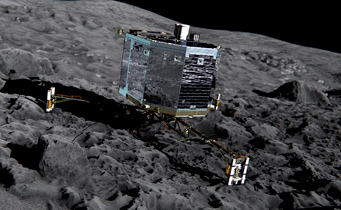Astronomy - Finally, ESA Locates Comet Lander Philae
It's taken nearly two years, but a dedicated search of craggy Comet 67P/Churyumov-Gerasimenko has turned up the long-lost landing craft Philae.
A key objective of the European Space Agency's Rosetta mission was to place an instrumented, washing-machine-size craft called Philae on the surface of Comet 67P/Churyumov-Gerasimenko. But not much went right during the landing attempt on November 12, 2014. Two systems designed to anchor the craft on the comet's rock-and-ice nucleus — a downward-pushing thruster and two harpoons — both failed. Set free in the comet's ultra-low gravity, Philae bounced twice before finally coming to restfar from its intended touchdown site.
The craft wasn't destroyed by all that, but it didn't land upright and ended up mostly in shadow. Unable to generate enough electricity via its solar-cell panels, Philae transmitted for 57 hours before it shut down.
Back on Earth, ESA engineers started the hunt for where, exactly, Philae had ended up. Mission engineers had arough idea of the landing site's location, a craggy spot on the smaller of Comet 67P's two elongated lobes (they even named it: Abydos). And hope surged 8 months later, when the Sun-warmed lander came to life long enough to fire off a few brief transmissions. But it wasn't enough for Rosetta, the orbiting mother ship, to identify the landing site.
However, ESA announced today that Philae has, at last, been found. As suspected, the lander lies wedged in a deeply shadowed crevice. It's tipped over onto one side, with two of three legs in view. Given that orientation, it's little wonder why the search took so long.

A trio of Rosetta images zooms in on the Philae lander, which was finally located on the surface of Comet 67P/Churyumov-Gerasimenko after many months of searching. The context image (upper right), taken April 15, 2015, shows the lander's location on one of the comet's two lobes; Rosetta's OSIRIS camera took the long-sought discovery image (left and lower right) on September 2, 2016, from an altitude of just 2.7 km.
ESA / Rosetta
ESA / Rosetta
Still, the mission team is thrilled. In less than a month (September 30th), they'll command Rosetta to drop to the comet's surface. So time to complete the search was clearly running out.

Ideally, Philae would have ended up like this on the surface of Comet 67P/Churyumov-Gerasimenko. But that didn't happen.
ESA / ATG medialab
ESA / ATG medialab
The discovery came on September 2nd, with Rosetta just 2.7 km (1.7 miles) above the comet's nucleus. From that altitude, the telephoto half of the orbiter's OSIRIS cameracould resolve details as small as 5 cm (2 inches). Finding the lander is more than a sentimental achievement; it will provide context for the scientific and engineering data that Philae managed to transmit to Earth.
"Now that the lander search is finished, we feel ready for Rosetta's landing and look forward to capturing even closer images of Rosetta's touchdown site,” notes Holger Sierks, principal investigator for OSIRIS, in today's announcement.
No comments:
Post a Comment